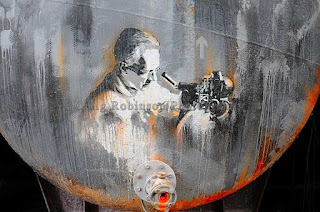or: How I Learned to Stop Worrying and Love the Binary Bomb.
Recently I heard the term
'digital disruption' while shooting a marketing event in Berlin.
Marketing professionals expressed concern over the digital wave which
is sweeping old business and marketing methods under a binary tidal
wave of ones and zeroes. The only thing to fear about inevitable
change is the ability to run with it. Rather than being afraid of
some robot taking your job, just think of technology as providing you
with cooler tools and toys to play with.
The Ages
I live the Information
Age, which is preferable to living in the Stone Age, the Bronze Age,
or the Dark Ages. I'm a photographer, so in a different age I suppose
I would have been the cave painter, the sword engraver, or the sketch
artist at the village fair. But I love the digital disruption
happening in photography equipment. I'm a right proper Old School
Photographer who once rolled celluloid into metal cameras and spent
too many hours breathing dangerous chemicals in dark rooms just to
get a few black-and-white images onto the pages of the weekly
hometown newspapers. Now I can breathe easy knowing I'm not polluting
my lungs or the water table with my photo chemicals, and I can see
and share the instant results of my work with clients, friends, and
the world. Nowadays only hipsters shoot with film.
Kodachrome
That sweet slide film Paul
Simon sang about was the best photography product of the analogue
age. No better image could be acquired on any medium at the time.
Film negatives yielded grainy results, the higher the ISO, the worse
they looked in print. But those incredible positive dyes in
Kodachrome required incredibly negative chemical nastiness and mess
to process. One of my early college photography professors once said:
“My students ask me when I will teach another Kodachrome processing
class. I answer: Have you heard of the second coming of Christ? Well,
the semester after that.” Kodachrome looks fantastic, but nobody
wants to deal with the ugly chemical process. It was eventually
phased out completely in the U.S. I remember sending my last roll of
Kodachrome to be processed in a lab in Texas. There's even a film
'Kodachrome' with Ed Harris as an old school photographer.
“We're preservationists,
by nature.
We take pictures to stop time...to commit moments to
eternity.
Human nature made tangible.”
- Ben, 'Kodachrome' 2017
The digital age of
photography hit like a monsoon in the new millennium. Before that,
only fools would pick up those cheesy, pixelated brick cameras and
try to work with them. It wasn't until 2005 that I bought my first
digital camera. I was still shooting negs at that time, and one day I
had just come to the Prague photo lab to collect my payload of
negatives from a week-long photojournalism assignment for a
Portuguese magazine called Visao.
Czechs are not known for
their friendly customer service, which at the best of times is like
trying to tickle a smile out of a badger. But when the photo lab
monkey said they hadn't processed my film yet (they only had a week
to do it), I showed them his manager's signature on a receipt
promising Friday delivery. “Oh” said the lab monkey, “He's in
the cottage.” So I wrested my unprocessed photo negatives from his
lethargic hands, handed them to the Portuguese reporter, who returned
to Lisbon with them. I never saw my negatives again. I got paid for
the job and got a copy of the magazine, but a photographer would
rather lose a kidney than his negatives. The very week after I bought
my first digital camera and never looked back. No more dirty
chemicals, no more waiting on monkeys, and no more losing my
negatives. Technology solved many problems in one fell swoop.
Disrupt This
While the tools of the
trade got better, they also paved the way for a new generation of
posers to enter the arena. With increasingly impressive digital
cameras being made every year, the technical skills required to make an
image became meaningless. Now seemingly any chump with a credit card
and a website could throw up their best 10 shots and call themselves a
photographer. This type of disruption diluted the pool of real
photographers, and many of us were rightly pissed off. But this
wasn't just about how the new cameras made it possible for a greater
number of people to take better pics. It was about the digital
disruption of professional photographers' marketing and networking.
With so many thousands of
photographers out there floating in the cyber-sea, old school
shooters now had to master social media, SEO key wording, and
blogging just to keep from drowning in a sea of amateurs with a few
pretty pics and a mastery of narcissistic self promotion. And as
always, the professional photographer needs to stay aware of the
changing trends in photography. How does a photographer trained in
photojournalism get work when newspapers are falling faster than the
trees needed to print them? I once shot mainly weddings in Prague in a documentary style. Now, fashion weddings are popular again, the
field is flooded with fashion photographers, and the destination
wedding industry has moved to other cities.
Now I mainly shoot
commercial events. My skills in photographing people have shifted
focus, as it were. And as one city loses its charm as a destination
for commercial events, I am happy to trot around Europe with my
camera to see new cities hosting corporate events. I do sometimes
miss the days of black-and-white films and the rich, silvery tones in
archival prints. Even then, I was trotting around Europe rolling my
own film and processing it in portable tanks. Only the joy of travel
remained constant.
Some things never change.



































